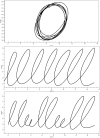A quantitative measure of handwriting dysfluency for assessing tardive dyskinesia
- PMID: 25679121
- PMCID: PMC4344392
- DOI: 10.1097/JCP.0000000000000277
A quantitative measure of handwriting dysfluency for assessing tardive dyskinesia
Abstract
Tardive dyskinesia (TD) is a movement disorder commonly associated with chronic exposure to antidopaminergic medications, which may be in some cases disfiguring and socially disabling. The consensus from a growing body of research on the incidence and prevalence of TD in the modern era of antipsychotics indicates that this disorder has not disappeared continues to challenge the effective management of psychotic symptoms in patients with schizophrenia. A fundamental component in an effective strategy for managing TD is its reliable and accurate assessment. In the present study, we examined the clinical utility of a brief handwriting dysfluency measure for quantifying TD. Digitized samples of handwritten circles and loops were obtained from 62 psychosis patients with or without TD and from 50 healthy subjects. Two measures of dysfluent pen movements were extracted from each vertical pen stroke, including normalized jerk and the number of acceleration peaks. Tardive dyskinesia patients exhibited significantly higher dysfluency scores than non-TD patients and controls. Severity of handwriting movement dysfluency was correlated with Abnormal Involuntary Movement Scale severity ratings for some tasks. The procedure yielded high degrees of test-retest reliability. These results suggest that measures of handwriting movement dysfluency may be particularly useful for objectively evaluating the efficacy of pharmacotherapeutic strategies for treating TD.
Figures



References
-
- Correll CU, Schenk EM. Tardive dyskinesia and new antipsychotics. Curr Op Psychiatry. 2008;21:151–156. - PubMed
-
- Kahn RS, Fleischhacker WW, Boter H, et al. the EUFEST study group. Effectiveness of antipsychotic drugs in first-episode schizophrenia and schizophreniform disorder: an open randomized clinical trial. Lancet. 2008;371:1085–1097. - PubMed
-
- Dean CE. The death of specificity in psychiatry: cheers or tears? Perspect Biol Med. 2012;55:443–460. - PubMed

